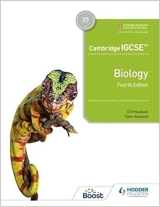Chapter 26. The human impact on the environment
Page 239
1. It takes longer and therefore costs more to make up a quota of small fish. Removing small fish from the sea depletes the breeding stock.
2. All cereals, grass for silage, soya beans, and oil-seed rape may be grown as monocultures.
a Advantages: high yields per hectare; easy to harvest in bulk; the same treatment can be applied to the whole crop.
b Disadvantages: rapid spread of infestation, bacteria, fungi or insects; imbalance of minerals removed from the soil; bad news for bees and many other beneficial insects and the creatures which prey on them.
3. a Advantages: they keep weeds, fungi and harmful insects under control.
b Disadvantages: they kill harmless and beneficial insects as well as pests; they may get into the food chain.
4. In bad (cold) weather, the birds use their fat reserves as a source of energy. When the fat is metabolised it releases the DDT into the blood stream.
5. An excess of nitrate in river water allows microscopic algae to grow and reproduce rapidly. When this excess population of micro-organisms dies, the remains are oxidised to carbon dioxide and water, making excessive demands on the supply of dissolved oxygen in the water.
Page 241
1. Logging for timber, cutting down trees to make way for agriculture, destruction of trees for firewood.
Forest trees reduce erosion on sloping ground; their absorption of water and transpiration can affect local climate; on a global scale they help to slow down global warming by absorbing huge amounts of carbon dioxide; forests offer a habitat for a wide variety of animals not found elsewhere.
2. The trees intercept the rain and allow it to soak into the ground but not wash it away. Their roots also help to keep the soil together.
3. The furrows should run at right angle to the direction of slope, i.e. along contours. This helps to retain rain. If the furrows ran downhill, heavy rain could form channels and carry the soil away.
4. a On a hillside, the trees intercept heavy rain and allow it to soak into the soil. Removal of trees allows the rain-water to run off the slopes and flood the valley beneath.
b Clear felling the trees leaves huge swathes of ground totally unprotected. The transpiration from the trees previously created water vapour, clouds and local rainfall.
The bare soil heats up in the sunlight, disperses local cloud cover and reduces rainfall.
5. The insecticide kills the springtails. Their numbers diminish and so do the numbers of mites which depend on them for food. When the insecticide eventually goes, the springtail population increases once more, but now there are fewer mites to eat the springtails and so their numbers soar until the mite population recovers and starts to eat them again.
Page 242
1. If the poisonous chemicals are dumped, animals and plants in the vicinity may be harmed. If they are buried, the poisons may kill the plants growing above or may be leached out into ground water and find their way into public water supplies or rivers where they harm wildlife.
2. The water about to leave the waterworks may contain a small residue of bacteria. Exposure to chlorine kills any remaining bacteria and the chlorine eventually evaporates.
3. The mercury was taken up by and accumulated in fish until it reached poisonous levels.
Page 246
1. Tall chimneys deliver the pollutants into the air well above ground level, but the pollutants are still there and may eventually find their way back to the surface (See Figure 26.20).
2. Acid rain contains sulphur dioxide and oxides of nitrogen which come mainly from factories burning coal and oil, and from exhaust gases of vehicles.
3. Carbon dioxide and methane both absorb long wave radiation reflected from the Earth’s surface and cause the atmosphere to warm up. |
Downloads
Download the answers in PDF format below
Section 1, Chapters 1-5
Section 2, Chapters 6-9
Section 3, Chapters 10-12
Section 3, Chapters 13-17
Section 3, Chapters 18-20
Section 4, Chapters 21-24
Section 5, Chapters 25-27
Section 5, Chapters 28-29
Section 6, Chapters 30-34
Section 6, Chapters 35-37
Section 7, Chapters 38-39
Section 8, Chapters 40-41
|
